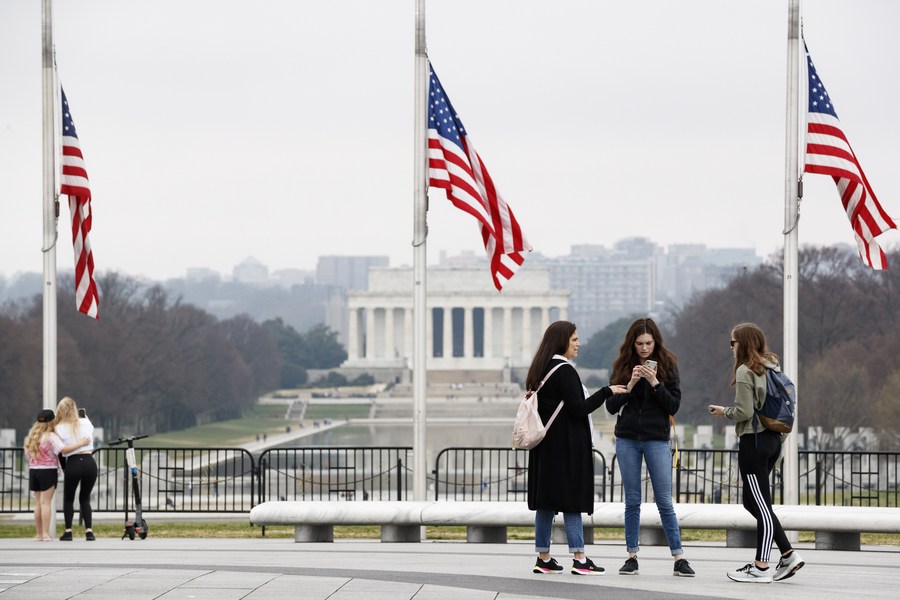U.S. witnesses increase in COVID-19 cases with spring break looming

People gather near the Washington Monument in Washington, D.C., the United States, on March 25, 2021. (Photo by Ting Shen/Xinhua)
The current seven-day moving average of daily new cases, which stands at 62,167, increased 8.4 percent compared with the previous 7 days.
WASHINGTON, April 3 (Xinhua) -- The United States is seeing an increase in COVID-19 cases, including cases from new and emerging COVID-19 variants, as experts are concerned about another surge amid the spring break.
COVID-19 cases in the country were steadily decreasing for approximately 10 weeks. However, trends are changing, and cases have increased during the past 12 days, according to data of the U.S. Centers for Disease Control and Prevention (CDC).
The current seven-day moving average of daily new cases, which stands at 62,167, increased 8.4 percent compared with the previous 7 days.
Meanwhile, the seven-day average of daily hospital admissions of COVID-19 patients, which stands at 4,948, is a 4.8 percent increase from the previous 7-day period, according to the CDC.
Overall, COVID-19 deaths in the country have decreased for the past 11 weeks, except for an increase during March 27 and 28.
Compared with the highest daily death peak on Jan. 13, which was 3,379 deaths, the current 7-day moving average of 880 daily new deaths decreased 74 percent, CDC data show.
Experts are concerned about another surge of new cases and increasing variants infections as lots of people are planning travels during the spring break.
The country recorded more than 13,000 infection cases of coronavirus variants as of Thursday, according to the latest data of the CDC.
Among these cases, 12,505 cases were caused by the variant known as B.1.1.7, which was originally detected in Britain.
There were 323 cases of the strain initially discovered in South Africa, called B.1.351, and 224 cases of the P.1 strain first discovered in Brazil.

People wait for their takeouts outside a restaurant on a business street in San Mateo, California, the United States, March 24, 2021. (Xinhua/Wu Xiaoling)
In addition, the B.1.427 and B.1.429 variants, two coronavirus strains first detected in the western state of California, are also being closely monitored by the CDC.
The five coronavirus strains are currently classified by the CDC as "variants of concern," as evidence shows an increase in their transmissibility, increased hospitalizations or deaths, significant reduction in neutralization by antibodies generated during previous infection or vaccination, reduced effectiveness of treatments or vaccines, or diagnostic detection failures.
"These variants of concern are mutated versions of the SARS-CoV-2 virus and have the potential to cause COVID-19 to be more severe, spread more easily between humans, require different treatments, or change the effectiveness of current vaccines," said the CDC in a report.
As of Saturday, more than 104 million people in the United States have received at least one COVID-19 vaccine dose, according to the CDC.
A total of 161 million COVID-19 vaccine shots have been administered by Saturday, while more than 207 million COVID-19 vaccine doses have been distributed across the country.
Currently nearly 60 million Americans have been fully vaccinated, about 18 percent of the whole population, according to the CDC.
"The race to vaccinate people and contain the virus is underway. The actions we take today determine how long it will take to stop the virus and end the pandemic," said the CDC.
Photos
Related Stories
- China approves clinical trials for CanSino's inhaled COVID-19 vaccine
- Chinese mainland reports no new locally transmitted COVID-19 cases
- 13 COVID-19 patients discharged from hospitals on Chinese mainland
- Global COVID-19 cases continue to rise for fourth consecutive week: WHO
- Nation prepares mass domestic COVID inoculations
Copyright © 2021 People's Daily Online. All Rights Reserved.










